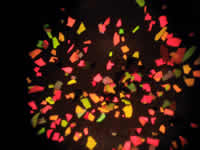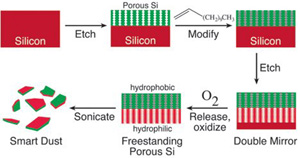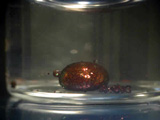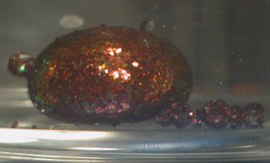Smart dust, tiny particles of silicon, have been produced by US chemists. The particles spontaneously assemble and orient themselves and sense their local environment, according to US researchers. The tiny photonic crystals could become the building blocks of electromechanical devices the size of a grain of sand useful in medicine, pollution monitoring and detecting chemicals made by microbes and other potentially harmful agents.
Michael Sailor and graduate student Jamie Link of the University of California at San Diego etched the surface of a silicon wafer to make it porous on one side. They could then coat this face with the oily, water-repelling, molecule dodecene. They then oxidise the other face of the wafer to make it hydrophilic, or water-loving. By using ultrasound (essentially high-frequency vibrations), they can break the chip into tiny pieces, each about the size of the diameter of a human hair. The resulting two-faced particles are thus water-repellent on one side and on the other water-attracting.

Tiny two-faced particles of silicon could reveal the presence of pollutants or toxic gases through a simple colour change. (Image Credit: Jamie Link, UCSD)
When the team added these particles to water and then dropped in a small amount of oil, the particles effectively do not know which way to turn, at once attracted to the oil and the water. The result is that the particles spontaneously migrate to the interface between the water and the drops of oil. The absorption of oil into the pores on the hydrophobic face causes a visible colour change, just as a butterfly’s wings reflect light. The spontaneous alignment of the particles will occur with water and any substance that is immiscible in water. The strength of the colour change depends on the identity of this insoluble substance. The liquid only wicks into the regions of the particle that have been modified chemically, explains Sailor. The presence of the liquid in the pores causes a predictable change in the colour code, signalling to the outside observer that the correct target has been located.
Because the two-faced particles collect at a target and self-assemble into a larger aggregate, the combined effect of hundreds or thousands of tiny mirrors reflecting colour is much stronger and more easily detected than that from a single mirror. The iridescent colour change might reveal the presence of a hazardous compound in drinking water or in the air. It could also provide a new type of phosphor for information displays and TV or computer screens.

Facing off – the particles seek out and attach themselves to an oil drop, presenting their red surface to the outside world and their green surface towards the inside of the drop
The researchers also suggest that the self-organising properties of smart dust could be exploited to make more complex structures by tailoring the surfaces with other molecules. With appropriate chemical species on each face, the particles could spontaneously assemble and align themselves into other arrangements. These might be used as building blocks for future microelectromechanical systems (MEMS).

A smart dust liquid drop
Ironically, the discovery of self-organising smart dust was a pure accident. The researchers were simply trying to construct smaller and smaller sensors and were repeatedly annoyed by tiny flakes coming off the silicon wafers with which they were working. It eventually occurred to Sailor that the tiny particles might themselves be used as sensors.

Red particle surface

Michael Sailor
Further reading
Proc Natl Acad Sci, 2003, in press
http://www.pnas.org/cgi/doi/10.1073/pnas.1233824100
Suggested searches
photonic crystals
microelectromechanical systems